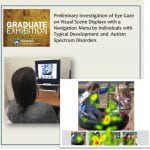
As part of the AAC Leadership Project, Tara O’Neill has been working with eye gaze technology in the PSU research effort to understanding visual-cognitive processing as a critical component of effective communication display design, resulting in more effective and efficient AAC interventions.
Her poster presentation at the 31st Annual Graduate Exhibition (March 20th, 2016), “Preliminary Investigation of Eye Gaze on Visual Scene Displays with a Navigation Menu by Individuals with Typical Development and Autism Spectrum Disorders” furthers previous research regarding how individuals that use AAC attend to, perceive, and make sense of the visual information of the display (Wilkinson, Light & Drager, 2012).
The PSU AAC academic community is committed to disseminating the results of our research to the field to advance knowledge and understanding. With this goal in mind, doctoral students are actively involved in writing papers for publication in journals or presentation at local, state, national, or international conferences.
More information:
– Gaze Toward Social Interactions in Photographs, ASHA 2015
– Building EBP in AAC Display Design for Young Children, AAC 2015
– Research on eye tracking to inform AAC design for individuals with ID, EyeTrackBehavior 2013
– Considerations for the composition of Visual Scene Displays: Potential contributions of information from visual and cognitive sciences, AAC 2012
– Gaze fixation during search for a symbol on AAC displays, ASHA 2011
Recent Presentations and Publications
Recent Graduate Student Research

ASHA 2022 Presentations by PSU Faculty and Students
Faculty and students presented at ASHA 2022 in New Orleans, LA.
